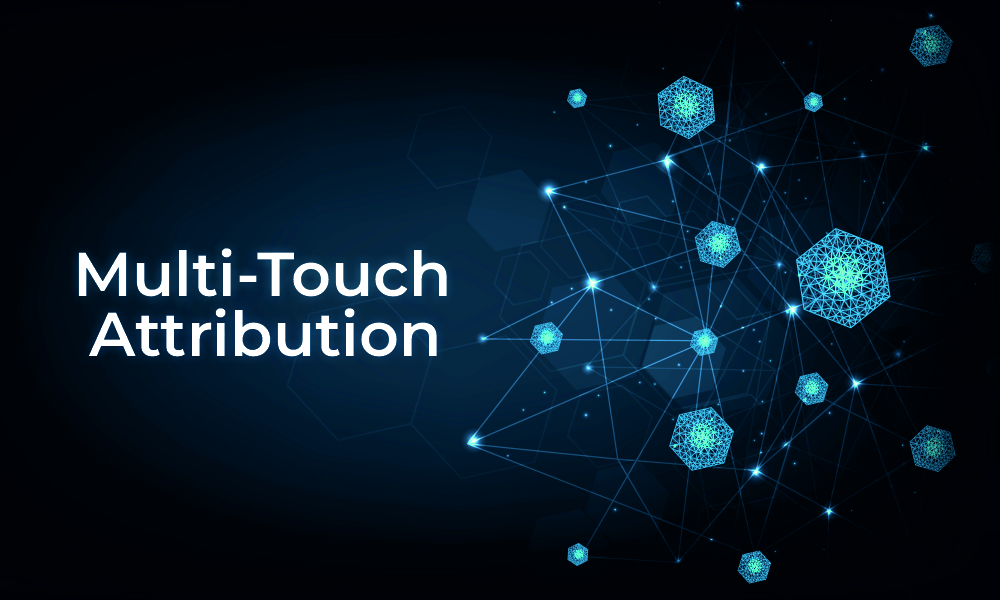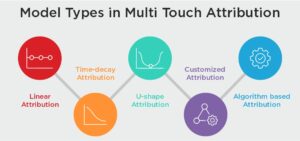The journey of a customer can have many touch points from the starting point to actually buying the product. This includes, a customer engaging with your product once whether it is a click, visit to a page, a Google search or even an interaction with customer service. So, when there are multiple touch points involved in a customer journey, then it is referred to as Multi-Touch Attribution.
In a marketing campaign, understanding where to allot the budget is very important, as part of that budget can be devoted to the touchpoints that have worked in the past. So, we need to understand the touchpoints that led to a positive action towards converting the potential customer into a customer. Knowing where not to divert the budget is also equally important, as that budget can be used in effective channels instead.
Here we will be discussing the types of attribution models, step-by-step implementation, and the benefits to maximize the returns on your investment.
Multi-Touch Attribution (MTA)
Multi-touch attribution is an approach to measure the credits given to the channels for all the touchpoints of a consumer journey. Certain number of credits are designated to each touchpoint which gives marketers an idea of the value of each touchpoint on driving a conversion.
A single touchpoint in the customer journey, usually the first or last interaction, is given full credit for a conversion or sale under the single-touch attribution marketing model. Multi-touch attribution, on the other hand, takes into account and gives credit to several touchpoints that influence the conversion, offering a more thorough comprehension of the customer's journey to buy.
Only Facebook would be credited in a single-touch attribution model if a customer clicked on a Facebook ad and went on to make a purchase. An MTA model, on the other hand, would give credit to each of the three touchpoints if the customer found the product via a Google search, interacted with a social media post, and then clicked on a display ad prior to making the purchase.
What Are the Model Types in Multi-Touch Attribution?
Implementing a plan is one thing but knowing which plan to implement comes first. We’ve listed the multi-touch attribution models that will help you make a correct selection.
Linear Attribution: The assigning of credit to each touch point is done equally in a customer journey. For instance, if a customer engages with an ad or a social media post and an email before a purchase, then each point of touch would get 33% credit.
Time-decay Attribution: A touch point closest to the point of purchase is given higher credit. It understands that the more recent the point of touch is to a conversion, the more influential it was to the decision making of the customer to purchase.
U-shape Attribution: It can also be called point-based attribution. The first and last touchpoints are assigned 40% credit while the leftover 20% is distributed between the touchpoints. Its credit distribution is heavy on the ends as it recognizes first and final engagement as important.
Customized Attribution: In this model, businesses can make their own specific rules of attribution depending upon their requirements. It can be a mixture of the other models, or it can be totally custom-made for their business goals.
Algorithm based Attribution: Machine learning algorithms are used to assign credits to touchpoints depending upon the effectiveness of conversion. The weightage of the credits is calculated by taking several factors and data into account.
Steps to implement multi-touch attribution
Due to the increasing complexity of the customer's journey, multi-touch attribution is not the simplest to set up. The biggest challenge in putting multi-touch attribution into practice is getting all the touchpoints across platforms, channels, and devices to communicate with one another. We’ve discussed the steps below.
Accumulate: You must first gather information about who is visiting your website, how did they arrive, and whether they became customers. JavaScript code and the UTMs will help you with finding out the information like when a consumer views the page, what activity the consumer performs on the page, where did the consumer came from (X, email, other social media apps etc.)
Make It Make Sense: You’ve got all the data, now you’ve got to make sense of that data by bringing it together in one place.
Also, it's now critical to consider the nature of your consumer journey. For instance, B2B companies will have to accommodate the various parties involved in the purchasing process as well as the lengthy cycle of several months. In this situation, account-based modeling, also known as B2B attribution, is essential for transforming data.
Application: An advanced analytics program is required when working with several intricate attribution models to normalize and correlate the data into easily understood metrics that can be used to extract insights. Along with other insights that could reveal the driving force behind a conversion, like brand equity or successful creative, this platform should provide person-level, granular data.
Marketers can start course correcting in real-time to create a more personalized experience once they believe they have a comprehensive understanding of how their campaign has performed based on the data provided by their attribution model.
In order to optimize and test campaigns, marketers should constantly analyze their multi-touch attribution data. Marketers should be able to identify the most effective tactics and marketing sequences to reach their customers at the ideal moment thanks to frequent optimizations and testing.
Benefits of Multi-touch Attribution
For marketers, particularly those aiming to gauge the effectiveness of digital campaigns, MTA models have gained significant interest. This is because they offer a more detailed, individual-level perspective than conventional aggregate techniques, like media mix modeling.
By revealing where spending is most and least effective, multi-touch attribution not only helps marketers enhance the customer experience but also increases the return on investment for their marketing expenditures. By presenting customers with fewer but more effective marketing messages, this can also help in reducing sales cycles.
Final Thoughts
Knowing the backstories of consumer interactions is now essential, not optional. Your company can gain important insights into the journeys of your customers by embracing the power of multitouch attribution. When done correctly, you can maximize your marketing efforts and eventually increase your revenue.
For more information and to stay upto date in the digital era with leading tech practices, visit KnowledgeNile.
Recommended For You:
The Future of Connectivity: Exploring Multi-Access Edge Computing in 5G
Google’s MUVERA Algorithm: How Multi-Vector Retrieval Improves Search Results</a






